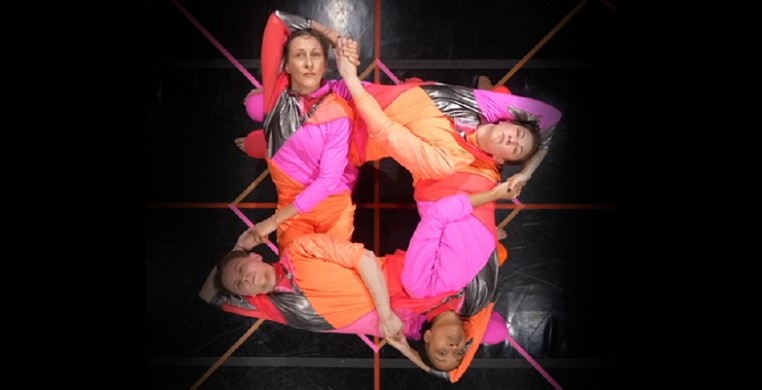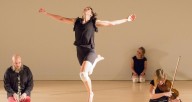A good work of art often challenges an audience to consider its subject from different vantage points—figuratively, of course. But a work by Ginger Krebs takes this literally, with mesmerizing results.
“All We Can See from Here” is created, directed, and performed by Krebs and presented at the Steppenwolf Theater—other dancers include Kennedy Alexandria, Lauren Kunath and Andy Slavin. The performance ran from Nov. 10 – 12 as part of Steppenwolf’s LookOut Series.
“LookDown” would have been more appropriate as the audience is invited to log on to a group Zoom meeting that allows the viewer to see the work from a camera mounted above the stage on their mobile device.
As the lights dim, a buzzing sound emanates from behind the audience, low at first but getting louder. A flying drone with two glowing red “eyes” emerges from the darkness to glare at the audience. It methodically moves, halts, rotates 90 degrees, scans the crowd, and repeats. (What does it want?) Having seen the opening scene of Terminator 2 a dozen times, it’s hard not to feel a chill run down my spine, and a sense of relief as the drone ominously meanders back the way it came.
The references to pop culture dystopia do not end there. Four dancers enter one by one, dressed similarly in uniforms made of bright pastel scraps by Sky Cubacub, giving off “Squid Game” vibes. The dancers stand on different points of an abstract-shaped box of colorful glowing tape, bifurcated by diagonal and perpendicular lines. Without any noticeable signal, the four play a game by leaping to different intersections of the shape, having to concede their position should they accidentally double up. Meanwhile, a soundscape by Joseph Kramer produces the tapping of distant pipes and the hiss and whistle of a steam leak, giving the impression that we are perhaps deep underground.
At intermittent intervals the contestants/prisoners link up arms to legs—or legs to necks, arms to arms, dozens of combinations—to create changing shapes that expand, contract and spin. This is for the benefit of the mounted camera overhead, which spins contrarily. The colorful morphing geometric patterns create the effect of a human kaleidoscope. The visual is astounding and shows clear attention to detail. It looks so good that it could be a show of its own.
Like other movies and TV shows in the niche sci-fi/horror/game show genre, the rules keep changing. Sometimes one contestant ventures out on their own. They test the boundaries by leaping over multiple lines, careful not to lose their balance. Sometimes they call out each other’s names, making it ambiguous whether they are in it to win it for themselves, or are a like-minded cooperative—“Who can we trust?” being another trope of sci-fi/horror.
The work, mostly set to ambient sounds, is not performed in a rhythmic vacuum. Emboldened and momentarily unrestricted, the quartet launch into a stage-spanning, arm-swinging march. Their footsteps alternate between stomping on the beat or syncopating off the beat; meanwhile, their synchronized breathing produces loud huffs every two beats, and dragging feet produce long, sustained swooshing notes.
The creepiest part comes towards the end, when they all attempt an escape, but become lost in the labyrinthine prison. As the lights dim, a soft whistle echoes across the chamber. Somewhere in the distance, the call is answered by a dissonant trio of whistles from the others. After the room is plunged into darkness, the call and response continue. It shifts around the room, growing fainter each time as they explore deeper and deeper into the maze.
Their fate is left open-ended—another mark of a good thriller. The viewer’s mind is left to wonder the “why” and “what,” and afterimages of the phosphorescent human pinwheel still spin in the mind. “All We Can See from Here” is both introspective and a spectacle, and you will see things differently afterwards.
-------------------------------------
For more information about Ginger Krebs and her work, please search See Chicago Dance by entering your query in the top right search bar on this website or click below!


